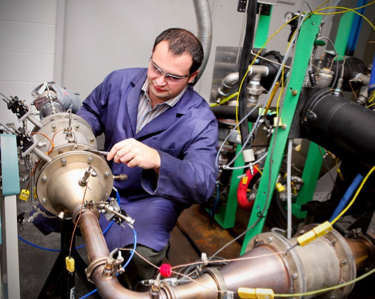
The fuels, engines, and emissions research laboratory is the most comprehensive capability in the DOE system for interrelated research on internal combustion engine efficiency, emission controls, and fuel effects. Specializing in research on high-efficiency combustion, emissions controls, emissions chemistry, renewable fuels, and lubricant technologies using innovative diagnostic instruments and research procedures developed within ORNL. The applications include engines for transportation, distributed energy, and portable power. Performing research on all system levels spanning basic chemistry and materials to components to engine systems to full vehicle applications. Experiments and modeling support consumer data for the popular FuelEconomy.gov website sponsored by the DOE and the Environmental Protection Agency. The R&D conducted leverages one-of-a-kind expertise and facilities at ORNL in the areas of leadership computing, neutron sciences, microscopy, materials characterization, advanced manufacturing, and biosciences.
R&D Focus Areas
- Advanced propulsion systems
- Fuel and lubricant technologies
- Aftertreatment and materials characterization
- Adaptive and self-learning engine controls
- Biomass-to-fuel catalyst technology development
- Unique diagnostics development
- Computational modeling
- Stationary power systems and auxiliaries
Equipment Highlights
- Seven double-ended hardware-in-the-loop ready motoring engine dynamometers ranging from up to 600 horsepower; three single-ended dynamometers supporting fundamental combustion engine research
- Multiple full-pass engine control systems
- Vehicle chassis dynamometer meeting requirements of EPA specifications for Large Roll Chassis Dynamometers with approximately 300 horsepower absorption capacity
- Analytical chemistry laboratory
- Catalysis function laboratories
- Bench-top exhaust flow simulators
In addition to multiple benches for regulated emissions measurements, research staff and instruments are capable of conducting speciation of exhaust constituents in great detail, while striving for fast time resolution. Several configurations of mass spectrometers and chromatographs are available, as well as Fourier transform infrared spectroscopy (FTIR). Capillary electrophoresis analyzes urea decomposition products. Exhaust volatile and semi-volatile constituent speciation can be performed. Exhaust particle characterization is accomplished through various methods, including time-integrated mass measurement on filters by tapered element oscillating microbalance, particle sizing by micro-orifice uniform deposit impactor system and scanning mobility particle sizer, composition analysis, and transmission electron microscopy for particle morphology.
Analytical laboratories accommodate flow benches and surface spectroscopy instruments for studies of catalyst kinetics and aging mechanisms. The fuels, engines, and emissions research laboratory has examples of a very rare and effective configuration of diffuse reflectance infrared spectroscopy (DRIFTS) and a well-equipped chemisorption apparatus.
Developing novel diagnostic instrumentation and providing it to researchers, either at the NTRC or, in some cases, at the researcher’s facility, for example, an engine plant. These instruments include:
- Spatially resolved capillary inlet mass spectrometer (SpaciMS), providing dynamic in situ chemical speciation of, for example, exhaust constituents or intake air
- DRIFTS for catalyst surface diagnostics
- Fiber optic–based phosphor thermometry for non-contact temperature measurements
- Exhaust gas recirculation corrosion probe
- Laser-induced fluorescence oil diagnostic
These capabilities and novel diagnostics support the study of the impacts of fuel and lubricant properties on advanced combustion processes, emissions, and emission control strategies and devices. The range of fuels studied includes gaseous (natural gas) and liquid fuels from conventional and unconventional fossil-based sources, as well as non-petroleum fuels from synthetic and renewable sources. The fuels, engines, and emissions research laboratory conducts research on innovative internal combustion engine technologies and control systems for improved efficiency. Combustion research combines fundamental novel concepts, multi-cylinder implementations, and full vehicle studies and simulations in order to understand the potential of new combustion concepts. Combining novel diagnostic and experimental methods with modeling, scientists also develop improved understanding of the functions and key mechanisms of emission control devices such as lean NOX traps, urea selective catalytic reduction, and diesel particulate filters, with emphasis on improving total system efficiency.

